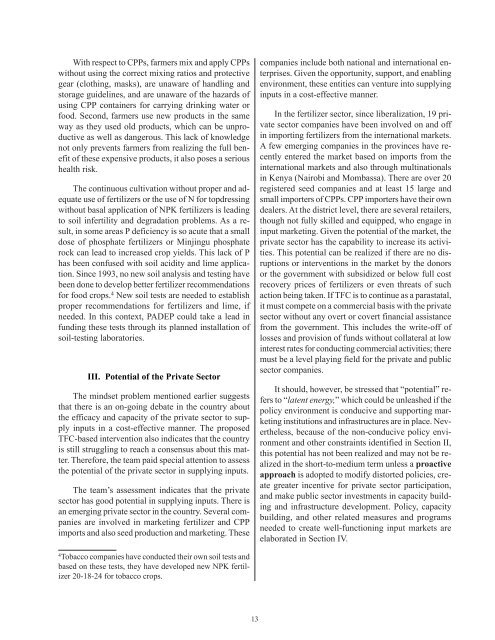An Action Plan for Developing Agricultural Input Markets in Tanzania
An Action Plan for Developing Agricultural Input Markets in Tanzania
An Action Plan for Developing Agricultural Input Markets in Tanzania
You also want an ePaper? Increase the reach of your titles
YUMPU automatically turns print PDFs into web optimized ePapers that Google loves.
With respect to CPPs, farmers mix and apply CPPs<br />
without us<strong>in</strong>g the correct mix<strong>in</strong>g ratios and protective<br />
gear (cloth<strong>in</strong>g, masks), are unaware of handl<strong>in</strong>g and<br />
storage guidel<strong>in</strong>es, and are unaware of the hazards of<br />
us<strong>in</strong>g CPP conta<strong>in</strong>ers <strong>for</strong> carry<strong>in</strong>g dr<strong>in</strong>k<strong>in</strong>g water or<br />
food. Second, farmers use new products <strong>in</strong> the same<br />
way as they used old products, which can be unproductive<br />
as well as dangerous. This lack of knowledge<br />
not only prevents farmers from realiz<strong>in</strong>g the full benefit<br />
of these expensive products, it also poses a serious<br />
health risk.<br />
The cont<strong>in</strong>uous cultivation without proper and adequate<br />
use of fertilizers or the use of N <strong>for</strong> topdress<strong>in</strong>g<br />
without basal application of NPK fertilizers is lead<strong>in</strong>g<br />
to soil <strong>in</strong>fertility and degradation problems. As a result,<br />
<strong>in</strong> some areas P deficiency is so acute that a small<br />
dose of phosphate fertilizers or M<strong>in</strong>j<strong>in</strong>gu phosphate<br />
rock can lead to <strong>in</strong>creased crop yields. This lack of P<br />
has been confused with soil acidity and lime application.<br />
S<strong>in</strong>ce 1993, no new soil analysis and test<strong>in</strong>g have<br />
been done to develop better fertilizer recommendations<br />
<strong>for</strong> food crops. 4 New soil tests are needed to establish<br />
proper recommendations <strong>for</strong> fertilizers and lime, if<br />
needed. In this context, PADEP could take a lead <strong>in</strong><br />
fund<strong>in</strong>g these tests through its planned <strong>in</strong>stallation of<br />
soil-test<strong>in</strong>g laboratories.<br />
III. Potential of the Private Sector<br />
The m<strong>in</strong>dset problem mentioned earlier suggests<br />
that there is an on-go<strong>in</strong>g debate <strong>in</strong> the country about<br />
the efficacy and capacity of the private sector to supply<br />
<strong>in</strong>puts <strong>in</strong> a cost-effective manner. The proposed<br />
TFC-based <strong>in</strong>tervention also <strong>in</strong>dicates that the country<br />
is still struggl<strong>in</strong>g to reach a consensus about this matter.<br />
There<strong>for</strong>e, the team paid special attention to assess<br />
the potential of the private sector <strong>in</strong> supply<strong>in</strong>g <strong>in</strong>puts.<br />
The team’s assessment <strong>in</strong>dicates that the private<br />
sector has good potential <strong>in</strong> supply<strong>in</strong>g <strong>in</strong>puts. There is<br />
an emerg<strong>in</strong>g private sector <strong>in</strong> the country. Several companies<br />
are <strong>in</strong>volved <strong>in</strong> market<strong>in</strong>g fertilizer and CPP<br />
imports and also seed production and market<strong>in</strong>g. These<br />
4 Tobacco companies have conducted their own soil tests and<br />
based on these tests, they have developed new NPK fertilizer<br />
20-18-24 <strong>for</strong> tobacco crops.<br />
13<br />
companies <strong>in</strong>clude both national and <strong>in</strong>ternational enterprises.<br />
Given the opportunity, support, and enabl<strong>in</strong>g<br />
environment, these entities can venture <strong>in</strong>to supply<strong>in</strong>g<br />
<strong>in</strong>puts <strong>in</strong> a cost-effective manner.<br />
In the fertilizer sector, s<strong>in</strong>ce liberalization, 19 private<br />
sector companies have been <strong>in</strong>volved on and off<br />
<strong>in</strong> import<strong>in</strong>g fertilizers from the <strong>in</strong>ternational markets.<br />
A few emerg<strong>in</strong>g companies <strong>in</strong> the prov<strong>in</strong>ces have recently<br />
entered the market based on imports from the<br />
<strong>in</strong>ternational markets and also through mult<strong>in</strong>ationals<br />
<strong>in</strong> Kenya (Nairobi and Mombassa). There are over 20<br />
registered seed companies and at least 15 large and<br />
small importers of CPPs. CPP importers have their own<br />
dealers. At the district level, there are several retailers,<br />
though not fully skilled and equipped, who engage <strong>in</strong><br />
<strong>in</strong>put market<strong>in</strong>g. Given the potential of the market, the<br />
private sector has the capability to <strong>in</strong>crease its activities.<br />
This potential can be realized if there are no disruptions<br />
or <strong>in</strong>terventions <strong>in</strong> the market by the donors<br />
or the government with subsidized or below full cost<br />
recovery prices of fertilizers or even threats of such<br />
action be<strong>in</strong>g taken. If TFC is to cont<strong>in</strong>ue as a parastatal,<br />
it must compete on a commercial basis with the private<br />
sector without any overt or covert f<strong>in</strong>ancial assistance<br />
from the government. This <strong>in</strong>cludes the write-off of<br />
losses and provision of funds without collateral at low<br />
<strong>in</strong>terest rates <strong>for</strong> conduct<strong>in</strong>g commercial activities; there<br />
must be a level play<strong>in</strong>g field <strong>for</strong> the private and public<br />
sector companies.<br />
It should, however, be stressed that “potential” refers<br />
to “latent energy,” which could be unleashed if the<br />
policy environment is conducive and support<strong>in</strong>g market<strong>in</strong>g<br />
<strong>in</strong>stitutions and <strong>in</strong>frastructures are <strong>in</strong> place. Nevertheless,<br />
because of the non-conducive policy environment<br />
and other constra<strong>in</strong>ts identified <strong>in</strong> Section II,<br />
this potential has not been realized and may not be realized<br />
<strong>in</strong> the short-to-medium term unless a proactive<br />
approach is adopted to modify distorted policies, create<br />
greater <strong>in</strong>centive <strong>for</strong> private sector participation,<br />
and make public sector <strong>in</strong>vestments <strong>in</strong> capacity build<strong>in</strong>g<br />
and <strong>in</strong>frastructure development. Policy, capacity<br />
build<strong>in</strong>g, and other related measures and programs<br />
needed to create well-function<strong>in</strong>g <strong>in</strong>put markets are<br />
elaborated <strong>in</strong> Section IV.

















